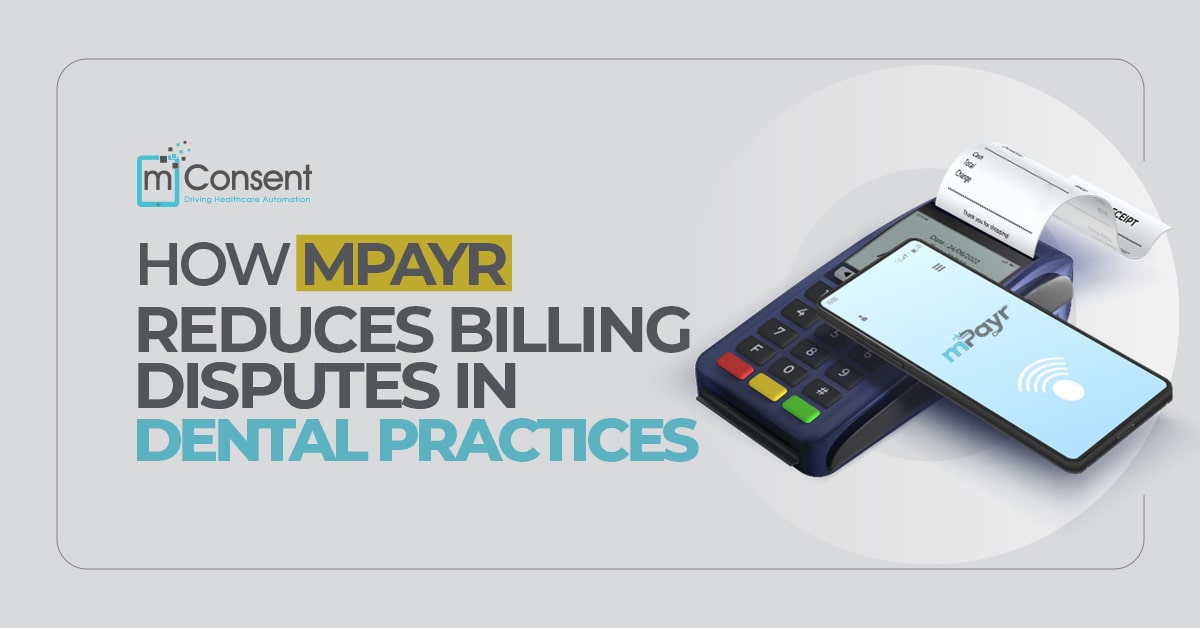In today's dental industry, strong communication skills and compliance with all applicable laws are essential. This balance cannot be reached without dental authorization. Consent forms make patients feel respected, educated, and acknowledged while making signing treatments easier, whether they are minor or substantial. Furthermore, they provide dental practitioners with legal protection.
Let's examine the key aspects of dental consent forms and how mConsent and other new digital solutions make the process easier, safer, and better for everyone.
Understanding Dental Consent Forms
A dental consent form is a written agreement between the patient and the dentist. It attests to the patient's understanding and agreement to proceed while outlining the details of a recommended approach.
Consent is all about trust. It ensures that patients actively engage in their dental journey, know what to expect, and believe in their treatment.
The Importance of Dental Consent Forms
- Legal Protection: Avoid disputes or accusations of wrongdoing against your practice in the future.
- Patient education: Provide patients with the knowledge they need to make wise decisions.
- Risk management: Keep an eye on all potential risks, consequences, and negative repercussions.
- Compliance: Verify that your practice complies with all legal requirements and medical guidelines.
- Professionalism: Being professional demonstrates your appreciation for patient dialogue.
Critical Elements Every Consent Form Should Include
Your permission forms should include the following items to protect your practice and provide for your patients effectively:
Patient Information
First things first: your complete name, date of birth, contact details, and patient identification number (if relevant). This ensures the records' correctness and maintains their organization.
Clear Description of the Procedure
Avoid using technical language. Talk using words that are natural and common.
Instead of saying, "We will be doing endodontic therapy," say, "A root canal will remove your tooth's damaged tissue."
Patients value transparency very much; simple language might help to build their confidence.
Purpose of the Treatment
Explain why the treatment is needed. This helps patients understand the value and importance of the procedure.
"This procedure is recommended to eliminate infection, relieve pain, and save your natural tooth."
Risks and Complications
The most important thing is honesty. Be honest about any possible issues or adverse consequences.
- Pain
- Swelling
- Bleeding
- Risk of infection
- Possible failure or need for retreatment
Even if risks are rare, patients should feel informed, not surprised.
Benefits of the Procedure
Balance the risks by listing the potential benefits:
- Relief from suffering
- Improved oral health
- Beauty and function were brought back
- Preventing further damage
This helps patients feel confident about their decision.
Alternatives to the Proposed Treatment
Patients should be informed about the risks of doing nothing, as well as about other therapies and the choice to do nothing. There are alternatives to this therapy, such as keeping an eye on things without doing anything or having the tooth extracted.
Acknowledgment of Understanding
Add a remark verifying the patient's ability to ask inquiries and perception that their issues were addressed. This stage focuses on informed consent, not merely agreement.
Voluntary Consent Statement
Make it clear that the patient chooses freely, without pressure. This is a vital legal safeguard and builds patient confidence.
Signatures and Date
A place for the patient's signature and the date should be at the end of the form. The signature of a witness or the supplier should also be included. Patients can sign electronically, safely, and easily for practices that use the mConsent iPad app.
Types of Consent Forms Dental Practices Should Use
Consent forms should be tailored based on the type of treatment. Common types include:
- General Treatment Consent
- Root Canal (Endodontic) Consent
- Surgical Procedure Consent
- Extraction Consent
- Anesthesia Consent
- Pediatric Consent
- Cosmetic Dentistry Consent
- COVID-19 Screening & Financial Policy Forms
mConsent gives you access to a library of legally authorized, customized forms in English and Spanish.
Going Digital: How mConsent Makes Consent Forms Simple and Smart
Paper consent forms come with many challenges—illegible handwriting, lost or misplaced documents, and the tedious process of scanning and storing physical copies. These inefficiencies not only slow down workflows but also introduce risks to data accuracy and compliance. That’s where mConsent transforms the process. By digitizing consent forms, mConsent eliminates these pain points, offering a streamlined, secure, and entirely paperless solution that saves time, reduces errors, and enhances the overall patient experience.
With fully digital, customizable electronic forms, dental practices can:
- Save 20+ minutes for every patient.
- Send consent paperwork before the appointment.
- Guarantee HIPAA compliance with end-to-end encryption.
- Your PMS (Practice Management System) will immediately sync everything.
- Steer clear of expensive scanning and printing headaches.
Best Practices When Using Consent Forms
To make your consent forms even more effective:
✅ Use clear, patient-friendly language
✅ Review forms with patients before they sign
✅ Allow time for questions
✅ Keep documentation organized and accessible
✅ Update forms regularly to reflect new regulations
✅ Train staff on how to explain and manage forms
At mConsent, excellent patient care starts with great communication.
Final Thoughts
In dentistry, permission forms reflect your dedication to patient care rather than just paperwork. A well-organized, unambiguous permission form shows your commitment to safety, openness, and informed decision-making. It tells patients that your work prioritizes their comfort and knowledge.
By including necessary elements and using digital technologies like mConsent, you simplify the procedure, improve communication, and lower risks. This increases operational efficiency and builds confidence and trust in your hospital. Adopting digital permission forms shows a forward-looking attitude that guarantees a more patient-centric, safer, and easier experience in all areas of dental treatment.
Ready to Elevate Your Consent Process?
mConsent offers a complete digital solution for dental practices:
- Electronic permission forms that can be changed
- Flawless PMS integration
- Remote access and iPad
- Legal compliance and a user-friendly interface for patients
- Forms for specialties and the Spanish language are available
- Instantaneous insurance confirmation
- Sharing of smart digital treatment plans
- User-friendly admin panel for form tracking
With mConsent, you don't just collect signatures—you build trust, improve efficiency, and protect your practice.
Explore mConsent's Digital Consent Form Solutions Today
Let's transform the way your practice handles consent.
""

![HIPAA Release Form – All you Need to Know [Instant Download]](https://mconsent.net/wp-content/uploads/2021/09/HIPAA-Release-Form-All-you-Need-to-Know-Free-Release-Form.jpg)















